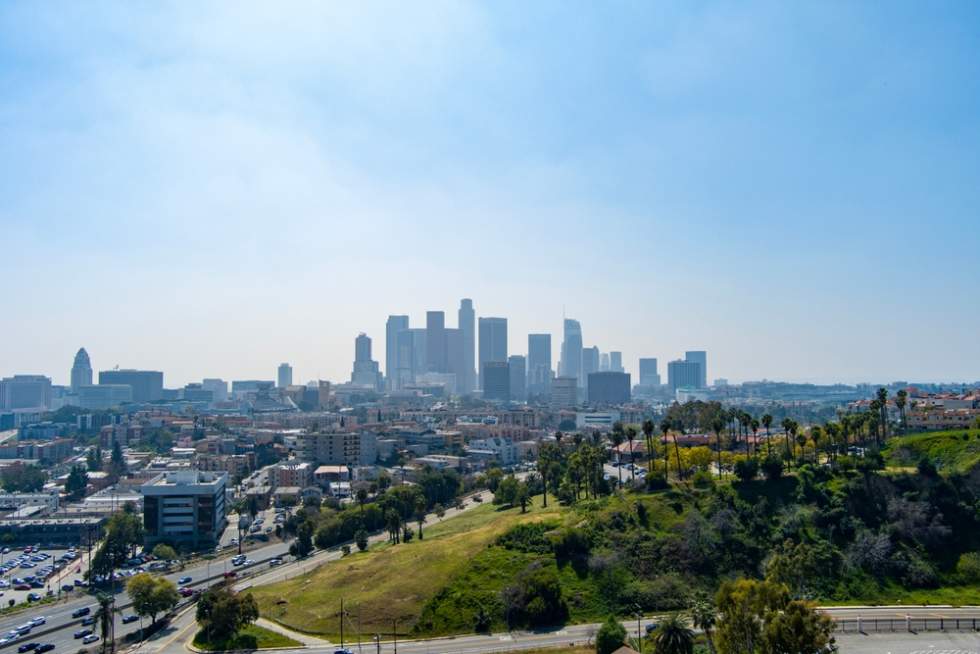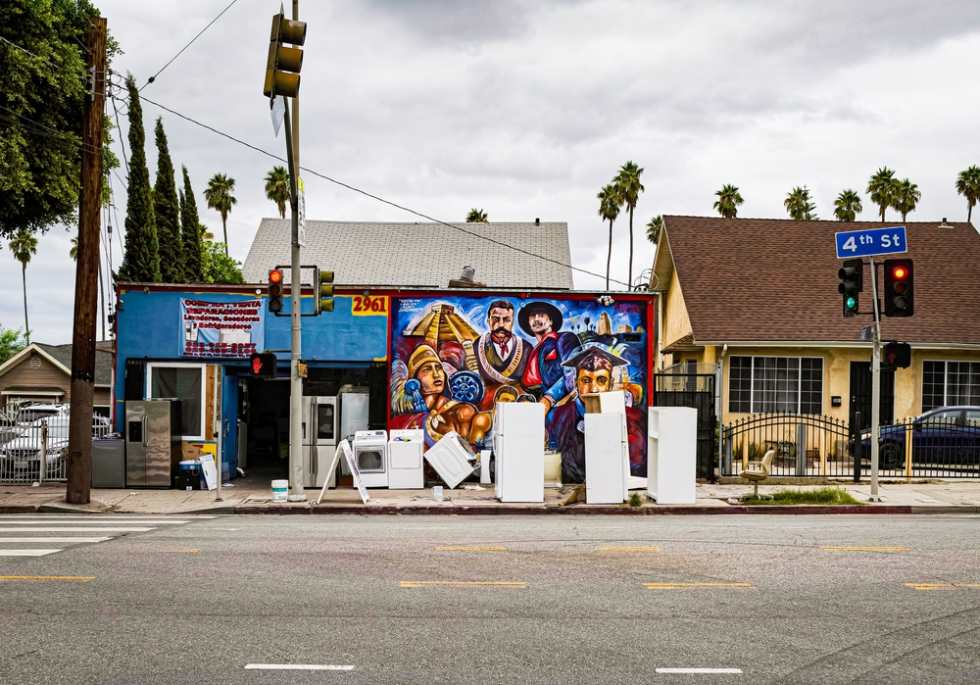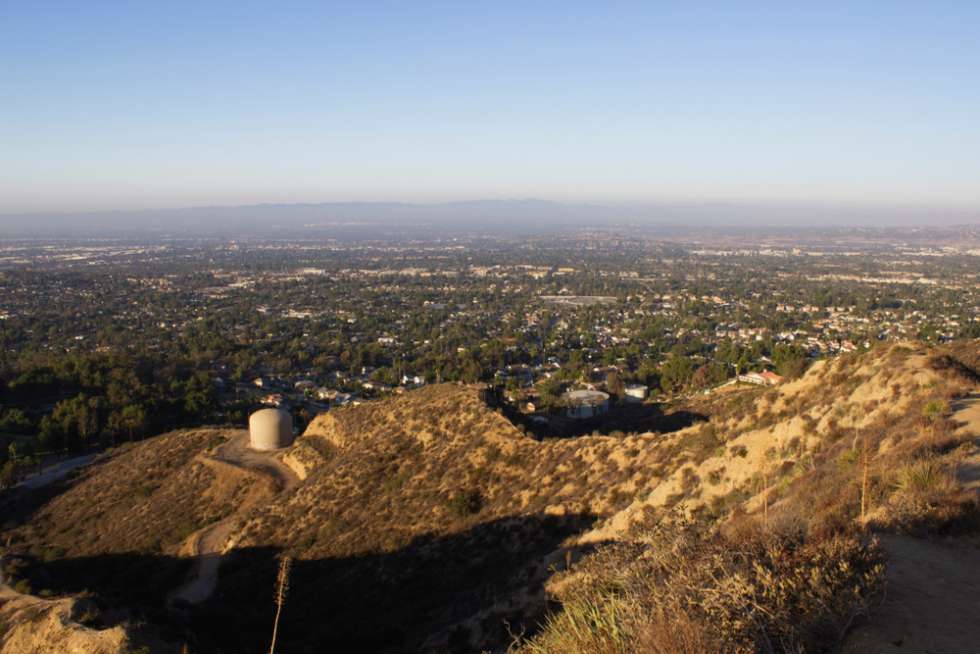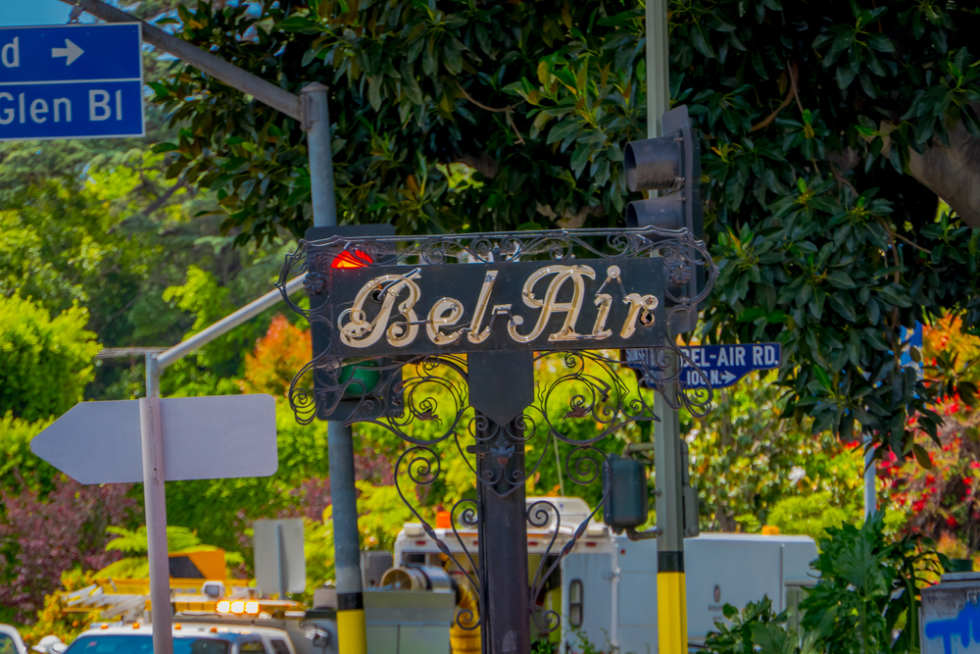Modera Argyle
- 66 units available
- 1 bed • 2 bed • 3 bed
- Amenities
In unit laundry, Patio / balcony, Granite counters, Hardwood floors, Pet friendly, 24hr maintenance + more

Los Angeles is not the most affordable city for renters in 2025. With a citywide median rent of $2,089, LA rents are 49.1% higher than the national average of $1,401, making it the 16th most expensive large city in the U.S.
Though LA rent growth has cooled, transportation costs and daily expenses remain steep, and renters must plan accordingly. However, Los Angeles rent is still 5.5% lower than the metro-wide median ($2,211), offering modest savings for those staying in the city proper. But don’t worry, Apartment List’s AI-matching quiz can help you find rental options that fit your budget and lifestyle.
Los Angeles’s rental market is stabilizing in 2025. As of July 2025, the median rent citywide is $2,089, virtually flat month-over-month and down 0.9% year-over-year.
After several years of volatility, 2025 has seen slower rent growth across LA. From January to June, rents rose just 1.1%, compared to 1.6% during the same period in 2024. In June alone, LA rents declined 0.1%, ranking the city #74 out of 100 major U.S. markets for rent growth. That’s below the national increase of 0.2% for the month.
With new construction slowing and demand gradually rebounding, industry watchers expect rent growth to remain modest. Concessions like one-month-free deals are becoming rarer, especially in sought-after areas like West LA and Koreatown. While LA remains one of the nation’s priciest rental markets, 2025 trends suggest a plateau, at least for now.
Rent in Los Angeles can fluctuate widely depending on the neighborhood, unit size, and building amenities. Coastal enclaves and trendy urban hubs tend to fetch premium prices, while inland areas and older properties offer more budget-friendly options. To give you a clear picture of what renters are paying today, here’s a breakdown of average rent prices across Los Angeles:
| Bedrooms | Los Angeles Average Rent Price | National Average Rent Price | Price vs. National (%) |
|---|---|---|---|
| Studio | $2,247 | $1,675 | +34.1% |
| 1-Bedroom | $2,513 | $1,762 | +42.6% |
| 2-Bedroom | $3,831 | $2,202 | +74.0% |
| 3-Bedroom | $5,646 | $2,733 | +106.7% |
As of July 2025, the average rent for a 1-bedroom apartment in Los Angeles is $2,513. Your actual cost can vary depending on factors like neighborhood (Koreatown vs. Brentwood), amenities (e.g., in-unit laundry, gym, pool), and proximity to transit lines like the Metro B Line.
As of July 2025, the median rent for a 2-bedroom apartment in Los Angeles is $3,831. These larger units are ideal for roommates, small families, or remote workers who want a separate office space, and rents can climb in high-demand areas like Silver Lake or West Hollywood.
Rent prices in Los Angeles are significantly higher than the national average, but they still trail prices in ultra-premium cities like New York and San Francisco. While LA is one of the most expensive cities in the U.S., its cost-to-lifestyle ratio can be worth it for renters who value year-round sunshine, access to beaches, and entertainment industry opportunities.
Here’s how Los Angeles stacks up in 2025:
| City | Average 1-Bedroom Rent | Cost of Living Index* |
|---|---|---|
| New York, NY | $5,015 | 172.5 |
| San Francisco, CA | $3,461 | 245.5 |
| Los Angeles, CA | $2,513 | 161.7 |
| Seattle, WA | $2,397 | 158.1 |
| Denver, CO | $1,800 | 127.6 |
| Phoenix, AZ | $1,480 | 113 |
*Cost of Living Index (U.S. average = 100) data sourced from BestPlaces.
Los Angeles sits in the mid-upper tier of affordability. It’s cheaper than coastal peers like NYC and SF, but notably pricier than Phoenix or Denver. That said, LA offers a better climate, a strong job market in tech and media, and diverse housing across neighborhoods, from the beachside apartments of Santa Monica to budget-friendly Valley rentals.
Before browsing listings, it’s worth brushing up on smart rent budgeting. While no rule is perfect, aiming to spend no more than 30% of your gross monthly income on rent is a solid starting point.
A commonly cited rule of thumb says your monthly rent shouldn’t exceed 30% of your gross income. So, if you earn $5,000 before taxes, you’d want to stay under $1,500 for rent. Sounds clean, but in LA’s complex rental market, where costs shift block by block, this is more of a compass than a contract. Use it to get a ballpark figure, but adjust based on your other expenses and lifestyle.
The 50/30/20 strategy splits your after-tax income into three parts:
Since rent is just one part of that 50%, it helps you keep housing in check without ignoring your future. It’s a great model for renters juggling LA’s cost of living while still trying to enjoy a night out in Silver Lake or street tacos in Highland Park.
This one’s all about income verification.
To qualify for an apartment, many landlords expect your monthly income to be at least three times the rent. For instance, if you’re eyeing a $2,200 rental, they’ll want to see a gross monthly income of at least $6,600. It’s a quick way for landlords to gauge affordability. Don’t meet it? Don’t panic. Co-signers, extra savings, or stellar references can still tip the scales in your favor.

Los Angeles is one of the priciest cities in the U.S., and it shows. The overall cost of living in LA is about 61.7% higher than the national average, driven largely by housing, which is more than three times the national benchmark. Groceries, utilities, and healthcare hover closer to the norm, but even small markups across categories add up fast when you live in a major metro.
Transportation is another big-ticket item. Whether you drive, rideshare, or take the Metro, getting around Los Angeles costs 65% more than the national average, thanks to long commutes, gas prices, and car ownership costs. While California’s mild climate keeps utility bills slightly below the national median, the high cost of rent more than offsets those savings.
That said, LA offers a level of opportunity and lifestyle that few cities can match, from beaches and food to job markets and entertainment. If you’re strategic about where you live, how you commute, and what you spend, it’s possible to enjoy the perks without breaking your budget.
Utilities in Los Angeles are more manageable than you might expect, especially considering the city’s high overall cost of living. Electricity costs average about $130/month, which is below both the California and national averages. Gas prices, however, are steeper at $68, and water bills come in around $50/month, which is slightly above the national norm.
| Location | Avg Electricity Cost | Avg Gas Cost | Avg Water Cost | Avg Fuel Cost | Avg Total Cost |
|---|---|---|---|---|---|
| Los Angeles, CA | 130.15 | 68.29 | 49.65 | 1.10 | 249.19 |
| California | 147.89 | 57.59 | 67.39 | 1.34 | 274.21 |
| U.S. | 150.93 | 51.12 | 45.52 | 5.57 | 253.14 |
Internet in LA averages $72/month, while renter’s insurance typically costs under $20. If you drive, expect to budget for fuel, parking, and routine car maintenance, especially since many Angelenos still rely on personal vehicles despite improvements to the Metro and rail system.
Where you live in Los Angeles has a big impact on what you’ll pay, and how you’ll live. From beachside apartments to urban lofts and quiet suburban escapes, LA’s most popular neighborhoods offer dramatically different rental prices and vibes. Below, we break down average rents in popular areas to help you find your ideal match.
| Area | Average 1-Bedroom Rent | Average 2-Bedroom Rent | Best For |
|---|---|---|---|
| Wilshire-Koreatown | $2,666 | $3,665 | Best for young professionals who want nightlife + transit |
| Silver Lake | $1,866 | $2,380 | Best for creatives and couples seeking artsy, walkable vibes |
| Culver City | $3,333 | $4,887 | Best for tech workers and commuters in the Westside tech hub |
| North Hollywood | $2,570 | $3,346 | Best for actors and artists near studios on a budget |
| Downtown LA | $2,988 | $4,206 | Best for urbanites who want skyline views and amenities |
| Santa Monica | $3,578 | $5,545 | Best for beach lovers with a higher budget and walkable perks |
| Highland Park | $2,407 | $2,882 | Best for trendsetters looking for vintage charm + new eats |
| Sherman Oaks | $2,474 | $3,140 | Best for families and remote workers who want a quieter base |
While Los Angeles is mostly known for its glitz, glamour, beaches, and cuisine, there are a few hidden gem neighborhoods that fall under the radar and below the city average in terms of apartment cost.
| Neighborhood | 1-Bedroom Average Rent | 2-Bedroom Average Rent | % Below Average Los Angeles Rent | Best For |
|---|---|---|---|---|
| Boyle Heights | $1,636 | $2,243 | 34.9% | Creative, budget-seeking renters seeking eastside culture |
| Pacoima | $1,800 | 28.4% | Working-class families and long-term locals | |
| Sylmar | $1,966 | $2,425 | 21.8% | Renters who want space, quiet, and proximity to nature |
| Greater Valley Glen | $1,930 | $2,650 | 23.2% | Commuters and families with mid-SFV convenience |
Just east of Downtown LA, Boyle Heights is rich in culture and community. Renters love the authentic Mexican food scene, from tacos at Guisados to pan dulce from El Tepeyac, and the historic Mariachi Plaza, which is a hub for local events and live performances.
Murals and street art bring color to the neighborhood, while the Gold Line Metro makes commuting into DTLA fast and easy. Despite its central location, Boyle Heights remains one of LA’s most affordable areas, making it popular with creatives, students, and professionals.

Located in the northeast San Fernando Valley, Pacoima has a proud Chicano heritage and a strong sense of neighborhood pride. Murals from the Mural Mile project line the streets, and locals gather at Ritchie Valens Park, named after the rock ‘n’ roll legend who grew up here.
Renters appreciate the lower cost of living and access to Hansen Dam Recreation Area, with trails, a lake, and even an aquatic center. It’s a great pick for families and commuters looking for space without leaving the LA city limits.
At the northern edge of Los Angeles, Sylmar is known for its small-town feel and mountain views. It's ideal for renters who want room to breathe. You’ll find larger apartments, some single-family homes, and proximity to nature. Locals love weekend hikes in the nearby San Gabriel Mountains and visiting the Wildlife Learning Center, a kid-friendly zoo alternative.
With quick access to the 210 and 5 freeways, Sylmar is perfect for nature lovers and suburban-minded renters who still want LA in their backyard.

A hidden gem in the central San Fernando Valley, Greater Valley Glen balances affordability with access. It’s just minutes from the NoHo Arts District and Sherman Oaks, but rents here are hundreds less.
Renters love the neighborhood’s walkable pockets, including Valley Glen Community Park and the tree-lined paths around LA Valley College. With easy access to the Orange Line and freeways, it’s a smart choice for young professionals, students, or anyone who wants a quieter spot near LA’s bustling core.
Of course, as one of the most expensive cities in the U.S., you can also expect to find several high-demand neighborhoods that are far more expensive than the national average.
Let’s take a peek at a few of these neighborhoods.
| Neighborhood | 1-Bedroom Average Rent | 2-Bedroom Average Rent | % Above Average Los Angeles Rent | Best For |
|---|---|---|---|---|
| Bel Air-Beverly Crest | $3,900 | $16,025 | 55.2% | Luxury estates and celebrity seclusion |
| Beverly Hills | $3,042 | $4,999 | 21.1% | High-end shopping and fine dining |
| Malibu | $6,432 | $8,704 | 155.9% | Ocean views and surfer lifestyle |
| Marina Del Rey | $3,510 | $5,094 | 39.7% | Waterfront living and boat access |
Home to sprawling hillside estates, gated compounds, and some of the most recognizable architecture in Los Angeles, Bel Air–Beverly Crest offers luxury living in a secluded, natural setting. Tucked into the Santa Monica Mountains, this area boasts winding roads, panoramic views, and quick access to Mulholland Drive. It's ideal for renters seeking prestige, privacy, and a retreat-like atmosphere just minutes from the city.

World-famous for its palm-lined streets and luxury boutiques along Rodeo Drive, Beverly Hills blends glamor with walkability. Renters here enjoy high-end shopping, 5-star restaurants, and cultural staples like the Wallis Annenberg Center for the Performing Arts.
Despite its price tag, Beverly Hills also offers excellent schools and a surprisingly neighborly vibe, making it a top pick for affluent professionals and families.
With over 20 miles of pristine coastline, Malibu is California dream living at its peak. Beachfront apartments and cliffside villas offer unbeatable ocean views, while local favorites like Zuma Beach and Malibu Pier create a laid-back, coastal lifestyle.
Whether you're surfing in the morning or enjoying wine tasting at a local vineyard, Malibu is a magnet for renters craving nature, solitude, and luxury rolled into one.

This breezy, harborfront enclave is a favorite among boaters, tech workers, and renters who want the perks of beach living without the tourist chaos of Venice. Marina Del Rey’s luxury high-rises and modern condos overlook peaceful waterways, while its waterfront promenade, kayaking rentals, and seafood dining scene make weekends feel like a vacation. Plus, it's just minutes from Silicon Beach employers and LAX.
To comfortably afford Los Angeles’s average one-bedroom rent of $2,513, you’d need to earn at least $100,500 annually, or about $8,375 per month, if you're sticking to the standard rule of spending no more than 30% of your income on housing. That number might seem steep, but it reflects the reality of renting in one of the most expensive housing markets in the country.
MIT’s Living Wage Calculator estimates that a single adult in Los Angeles County needs to earn at least $26.63 per hour, or roughly $55,400 per year, just to cover basic living expenses without financial stress. For a family of two working adults with one child, that number jumps significantly to $43.61 per hour per adult, more than $90,700 per year per person.
Still, not everyone who lives in LA earns six figures. Many renters make it work with creative budgeting, living in more affordable neighborhoods like Boyle Heights or Sylmar, renting studios instead of one-bedrooms, or splitting rent with roommates. If your salary is in the $60,000–$75,000 range, you may still find a comfortable place by adjusting your housing expectations and exploring transit-friendly areas that offer lower-than-average rent.
Even if you’ve budgeted for rent, utilities, and groceries, renting in Los Angeles can come with a few extra costs that catch new renters off guard. These “hidden” expenses can quickly stack up if you’re not prepared, and they vary depending on your landlord, location, and lifestyle.
Here are some of the most common additional costs to factor into your rental budget:
Renter’s Insurance: Many landlords require renter’s insurance, and even if they don’t, it’s a smart move. Expect to pay around $12–$20/month, depending on your coverage. It protects your belongings in case of theft, fire, or water damage.
Application Fees: When applying for an apartment, you’ll likely pay $30–$60 per adult for a background and credit check. If you're applying to multiple units, this adds up fast.
Security Deposits: California law caps standard security deposits at 1x monthly rent for unfurnished units (or 2x for furnished), but some landlords tack on pet deposits or cleaning fees.
Pet Rent & Deposits: Have a furry friend? Most buildings charge $25–$75/month in pet rent, plus a non-refundable pet deposit that can be several hundred dollars.
Parking Fees: Many LA apartments charge $50–$200/month for a reserved parking spot, especially in high-demand neighborhoods like West LA or Koreatown.
Amenity Fees: Fancy rooftop? Gym? Package lockers? Some buildings charge amenity or maintenance fees of $25–$100/month, especially in new developments.
Move-In/Move-Out Fees: It’s not unusual for buildings, especially high-rises, to charge elevator reservation fees, move-in deposits, or even HOA fees if you’re renting a condo unit.
Trash & Utility Pass-Throughs: Even if utilities are "included," some landlords pass along trash, water, and gas surcharges in the lease, typically listed as RUBS (Ratio Utility Billing System).
Key Fob or Remote Fees: Losing your gate remote or mailbox key? Replacements can cost $50–$150 depending on the property.
Before you sign a lease, always ask for a full breakdown of costs so you can budget realistically. What looks like a great deal on paper might be more expensive once all the extras are factored in.
Renting in Los Angeles isn’t cheap, but that doesn’t mean you’re stuck paying top dollar. With a little strategy and research, you can find smart ways to lower your housing costs or stretch your budget further. From government assistance to lease negotiation tips, here are some of the most effective ways to save on rent in LA:
If you're struggling to make ends meet, rental assistance programs can help cover part or all of your rent. The Los Angeles Housing Department (LAHD) offers emergency rent subsidies and Section 8 vouchers for eligible renters. Many nonprofits, like Coalition for Responsible Community Development, also offer short-term aid. These programs often prioritize seniors, families, and those affected by job loss or rising housing costs.

Yes, it’s possible, even in LA. If an apartment has been sitting vacant or you're signing during the slower winter season, landlords may be more open to a lower monthly rate, waived parking fees, or free months in exchange for a longer lease.
Bring comparable listings, offer to move in quickly, and don’t be afraid to ask for concessions. A polite negotiation can save you thousands over the course of a lease.
Splitting a two-bedroom with a roommate can significantly cut your costs, especially in high-rent areas. Even if you prefer your own space, some renters find that co-living setups with private bedrooms and shared kitchens strike the right balance between affordability and privacy. Apps like Roomi, Roomster, and SpareRoom help you connect with vetted housemates.
It’s tempting to rent in trendy spots, but you’ll get better value if you explore up-and-coming neighborhoods. Areas like Pacoima, Sylmar, or Boyle Heights often offer lower rents while still being transit-accessible.
If you work from home or have flexible hours, choosing a neighborhood just outside the downtown core can save you hundreds per month without sacrificing convenience.
Even if you score a lower monthly rent, you’ll still need to plan for first month’s rent, security deposit, application fees, and potentially pet deposits or moving costs. Setting aside a separate “moving fund” of at least 2–3x your monthly rent can help you act quickly on a great listing, and avoid falling into debt right after moving.

Understanding tenant protections can help you avoid surprise rent hikes or illegal fees. LA has strict rent control laws for buildings built before October 1978, plus just cause eviction protections and caps on annual rent increases for some newer units. Visit the Los Angeles Housing Department’s website to learn what rights apply to your building, and use that knowledge to push back against unfair practices.
You don’t have to scroll for hours or bounce between dozens of rental sites. Whether you're eyeing affordable spots like Sylmar or want to splurge in Marina del Rey,
Apartment List makes it easy to match with places that fit your budget, lifestyle, and move-in date. Just take our quick quiz and get instantly personalized results, because five minutes now can save you countless hours later.
Yes, for the most part, renting is significantly cheaper than buying a home in Los Angeles. The median home price is almost $900,000, which often requires a six-figure salary, a hefty down payment, and strong credit. Renting, on the other hand, provides more flexibility and lower upfront costs, especially if you’re not ready to commit long-term.
Absolutely. With limited supply and high demand, especially in central or coastal neighborhoods, competition can be fierce. Apartments in desirable areas often rent quickly, so it helps to act fast, have your paperwork ready, and consider touring mid-week to beat the weekend crowds.
According to MIT’s Living Wage Calculator, a single adult in Los Angeles needs to earn at least $26.63 per hour, or about $55,390 annually, just to cover basic expenses. For families, that number jumps significantly depending on household size and childcare needs.
If you’re struggling with rent, you may qualify for rental assistance through programs like the California COVID-19 Rent Relief, Section 8, or local non-profits offering emergency housing grants. You can also consider getting a roommate, exploring lower-cost neighborhoods, or negotiating with your landlord for temporary flexibility.
Not usually. In most Los Angeles rentals, utilities like electricity, gas, water, and trash are billed separately. Some buildings may include water or trash collection, and occasionally internet in larger complexes, but it varies. Always double-check what’s included before signing a lease.

In unit laundry, Patio / balcony, Granite counters, Hardwood floors, Pet friendly, 24hr maintenance + more
In unit laundry, Dishwasher, Pet friendly, Stainless steel, Gym, Pool + more